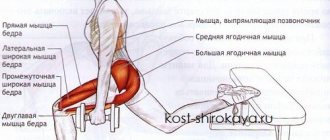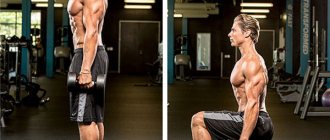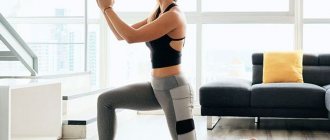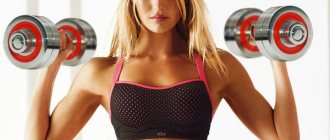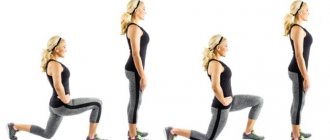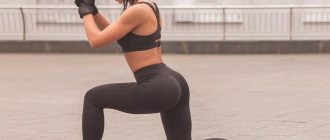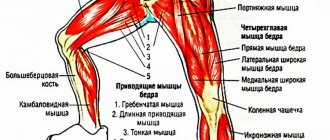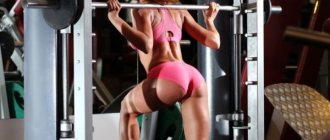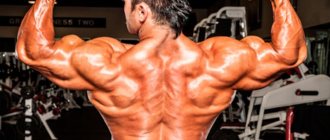Bulgarian lunges, or "back leg elevated split squats," are technically a regular squat, but these squats are performed on one side with one leg on an elevated bench and the other firmly planted on the floor.
Split squats work a huge amount of lower body muscles and, unlike traditional squats, do not place increased stress on the lower back. If you don't have weights on hand or don't have access to machines, this exercise is a great substitute for bodyweight squats. It will allow you to increase the resistance - you can gradually make it more difficult and progress.
Rules for performing the exercise
- Stand up straight. Hold your hands in front of you at chest level.
- Place your back leg on a hill.
- As you inhale, do a squat while keeping your back straight. When performing the exercise, the front knee should be in line with the foot.
- At the bottom point, focus on your heel and, as you exhale, straighten your leg to return to the starting position.
- Repeat as many times as necessary and change legs.
Short description:
Stand up straight, hold your arms in front of you at chest level. Place one leg on a hill. As you inhale, perform a squat, keeping your body motionless. As you exhale, return to the starting position. Perform the required number of times and change legs.
Detailed exercise technique using a video example from Yaroslav Brin.
How to perform Bulgarian lunges correctly
Place your leg on a raised platform, place your hands on your belt or hold them in front of your chest. Straighten your back and tighten your abs.
Bend your supporting leg and squat until your thigh is parallel to the bench. Do not try to reach the floor with the knee of your posterior limb. Let it remain 5-10 centimeters from the surface.
Make sure that the heel of the supporting leg does not leave the floor at the bottom of the exercise. If you cannot resist this, reduce the range of motion - sit down until you can keep your entire foot horizontal.
Straighten up from the squat, controlling the position of the knee of the supporting leg: it should be directed straight forward.
What muscles work?
Bulgarian squats are typically performed to sculpt the buttocks and legs. When performing split squats, the following muscles are used:
- Gluteus medius and maximus muscles.
- Rectus femoris muscle.
- Vastus lateralis and biceps femoris muscles.
- Semimembranosus muscle.
- Adductor longus muscle.
- Adductor magnus muscle.
- Semitendinosus muscle.
- Vastus medialis muscle.
In addition, the load is also placed on the stabilizer muscles:
- Muscles of the body.
- Gluteus minimus and medius muscles.
If you perform an exercise with weights or dumbbells, a static load is applied to your arms.
How to choose weight, number of approaches and repetitions
If you're doing weight training, do three to five sets of 8 to 12 reps on each leg. Select the weight in such a way that the last repetitions in the approach are difficult, but without any flaws in technique.
In other words, if by the 12th time the burning sensation in your hips increases, but you can still straighten your leg without lying with your stomach on your knee and without turning the joint inward, the weight is chosen correctly.
If you are training without weights, you can increase the number of repetitions to 20-25 times to achieve sufficient muscle stimulation. You can also add jumping - the explosive component will increase the load.
Advantages and Disadvantages of Split Squats
Since Bulgarian split squats are an effective but traumatic exercise, in addition to their advantages, they also have disadvantages.
Advantages:
- The main load falls on the muscles of the front leg, which allows you to work the target muscles as efficiently as possible. This approach allows you to eliminate imbalances and better work out the athlete’s left or right leg.
- Balance training. Because the back leg is used solely for support, the core stabilizer muscles are recruited to maintain balance. In addition, while performing Bulgarian split squats, the mobility of the hip joints develops.
- Squats will be a great addition to your main workout.
- Light load on the back, unlike regular squats.
- Another advantage of Bulgarian lunges is that they are not demanding on equipment. The exercise can be done anywhere, even at home in front of the TV.
Disadvantages of the exercise:
- Squats place increased stress on the joint of the working leg.
- To perform squats correctly, good stretching is necessary.
The benefits and harms of exercise
The benefits of Bulgarian lunges are obvious: this is an excellent exercise for comprehensively working the leg muscles. It is suitable for both men who want to achieve developed muscular legs, and young girls who simply want to keep themselves in good shape and not gain excess weight.
Bulgarian lunges do not carry any particular potential harm. Isolated cases where athletes were injured while performing them are associated with their own carelessness and excessive self-confidence.
The cause of injury can be: excessively heavy working weight, incorrect technique of performing the exercise, lack of stretching for comfortable performance.
However, do not forget that the exercise still contains a certain element of axial load on the spine. Therefore, you should not get carried away with heavy working weights here - this way you will overload the joint-ligamentous apparatus, already tired from basic exercises. People who have suffered an umbilical hernia are advised to use an athletic belt when performing Bulgarian lunges, as with other leg exercises.
Split squats with weights
Depending on the goal that the athlete sets for himself, Bulgarian squats can be performed with various weights, for example, kettlebells, barbells or dumbbells. It is worth noting that for this exercise it is recommended to use minimal weight.
Bulgarian lunges with barbell
Split squats with a barbell are among the most difficult variations of the exercise. This is explained by the fact that it becomes very difficult to maintain balance. If you want to try doing squats with a barbell, be sure to ask a trainer to back you up.
Bulgarian barbell squats
Stand with your back to the bench, place the barbell on your shoulders. Place one foot on the bench. As you inhale, slowly squat until your thigh is parallel to the floor. As you exhale, return to the starting position. Repeat as many times as necessary and change legs.
Bulgarian squats with a barbell in a Smith machine
Alternatively, you can do split squats in a Smith machine.
Bulgarian squats with a barbell in a Smith machine
Place a bench behind Smith's car. Take a barbell, place one leg slightly in front, and place the other toe on the bench. As you inhale, begin to slowly lower the barbell, bending your knees. As you exhale, stand up.
Bulgarian split squats with weight
If you have good technique for doing split squats, then you can try adding weights. You don’t need to take on heavy weights right away, just start with a minimal one.
Bulgarian split squats with weight
Stand up straight, hold the weight plate in front of you at chest level. Place one leg on a hill. As you inhale, perform a squat, keeping your body motionless. As you exhale, return to the starting position. Perform the required number of times and change legs.
Split squats with dumbbells
Training with dumbbells. Training with dumbbells will create additional stress on the stabilizer muscles. Alternatively, you can use weights.
Bulgarian split squats with dumbbells
Hold dumbbells at arm's length along your body or overhead.
To further complicate the movement, you can use a less stable platform for the non-active leg, such as a fitball or exercise ball.
Make exercise part of your workout
The best way to fit them into your schedule is to do them first on the day you develop lower body strength, after warming up but before doing any other movements. It is better to combine them with other types of training, such as running, isolation exercises, such as single-leg presses.
You can safely perform this exercise 4-5 times a week.
To make this workout easier for a beginner, perform it with both feet on the floor. This will make it easier for you to adjust to split squats. There's no need to balance your body, and you can focus on strength, Murrieta says.
And to make it more intense, add weight - hold dumbbells at your sides, hold a kettlebell in your hands, or put a barbell on your shoulders. But start light - even a little weight makes this exercise more difficult.
Other Squat Variations
Split squats are not demanding on equipment, which is why they can be performed not only with various weights, but also with various supports. For example, Bulgarian squats can be performed based on:
- Chair.
- TRX loops.
- Fitball.
- Bench for bench press.
Bulgarian split squat with rear leg hanging
You can use any loops or rubber to keep your non-working leg suspended.
Bulgarian split squat with rear leg hanging
Position the belt so that the handle is 45-75 cm from the floor. Take a long stride and place the foot of your left foot into the handle behind you. Bend your right leg at the hip and knee and lower yourself down. Bring your entire body to your heel. Rise to the starting position.
Bulgarian lunges TRX
TRX loops are gaining popularity in functional training. Performing split squats with them is especially difficult to maintain body balance.
Inclusion in the training plan
The main rule is that you should never perform Bulgarian lunges at the beginning of a workout. In most cases, all injuries during exercise are associated with either insufficiently warmed muscles and tendons, or with the use of high weights or number of repetitions. An example of incorporating Bulgarian lunges into a training regimen on leg day:
- Squats with a barbell 4*10;
- Romanian deadlift 4*10;
- Bulgarian squats 4*12;
- Lunges 4*12;
- Leg bending and extension (superset) – 3*15;
- Calf raise 4*12-15.
If Bulgarian squats are performed as part of a CrossFit workout or as a separate exercise, before which the muscles are not subjected to sufficient load to warm up, it is necessary to perform a thorough warm-up. Particular attention is paid to the ankle and knee joints. Be sure to perform several warm-up sets for the calf area, this will help avoid injuries to the Achilles tendon in the supporting leg.
When working without weight, you should focus on 4-5 approaches, with 12-20 repetitions in each. The number of repetitions depends on the level of training. When working with weights, it is recommended to perform no more than 10-12 repetitions. It is also important to remember that one set always includes the same number of repetitions for the left and right legs. It is absolutely unacceptable to perform a different number of repetitions for each leg (even if one limb gets tired faster). This will lead to muscle imbalances and musculoskeletal problems in the future.
Bulgarian lunges or squats.
Recommendations
In order not to harm the joints and “squeeze” the maximum benefit out of the exercise, you must adhere to the following recommendations:
- If you are just starting to train, do not rush and immediately do lunges with weights. First you need to prepare your muscles and learn the correct technique. To do this, contact an experienced trainer or slowly work through the exercise in front of a mirror.
- Don't forget to pay attention to the anatomy of your squats. The knee and toe should be pointing forward.
- Your back should remain straight during a split squat. If you constantly want to lean over, it most likely means that your front leg is too close to the support.
- Don't forget to watch your breathing. Deep breath - squat. Exhale - smooth rise.
Alternative Exercises
What mistakes should you avoid when performing Bulgarian lunges?
These flaws in technique reduce the effectiveness of the exercise and make it dangerous for the joints and back.
Swing
Some people move slightly backward when squatting. Due to this, part of the load is removed from the supporting leg, and the risk of falling increases. Therefore, try to move in a straight line and up and down to fully engage the working limb.
Turning the knee inward
If the knee of the supporting leg turns inward during the lift, the joint is in an unstable position, which can lead to ligament injury. Therefore, make sure that the knee points clearly forward or even turns slightly outward.
Excessive body tilt
Frame: Colossus Fitness / YouTube
If your leg muscles aren't strong enough, your torso may fall forward during the lift, so you're practically lying on your stomach on your thigh. To avoid this, do not lower your gaze and direct your chest horizontally.
Incorrect position of the foot on an elevation
If your foot is too far from the edge of the rise, it will prevent you from performing the full range of the squat. Only a sock should be on a chair or bench.
How are they different from ordinary ones?
The position of the legs is more convenient for working the muscles of each leg - in the Bulgarian lunges, one leg is suspended, while the classic lunge uses both legs. Both exercises work the same muscle groups, but the dumbbell lunge distributes the load between both legs, while the Bulgarian lunge targets only the muscles of one leg , making this exercise more tiring and difficult.
If you compare the two exercises, classic lunges allow you to use larger weights. However, Bulgarian lunges create constant tension on the supporting leg, and the amount of work performed on the front leg is greater than with a dumbbell lunge.
In addition, a team of researchers led by Professor McCurdy (USA) compared barbell squats and Bulgarian lunges and found that EMG activity (electrical activity of individual muscle fibers) in the gluteal muscles and hamstrings was significantly higher in Bulgarian lunges than in squats. barbell
Various variations of back lunges
Thus, we can conclude that if your goal is to improve the shape of your buttocks and add hamstrings to your biceps, then it is better to use Bulgarian lunges.
BUT : another study found that after performing both exercises, the concentration of testosterone levels in the athletes’ bodies showed almost identical levels.
Therefore, a split (read what a split is here ) of squats with a barbell and Bulgarian lunges has a positive effect on the hormonal environment and, as a result, the desired hypertrophy (i.e., increasing your Madam Siju
